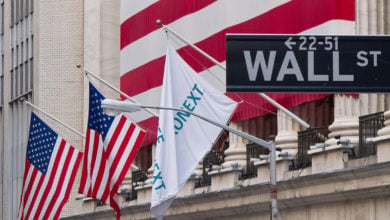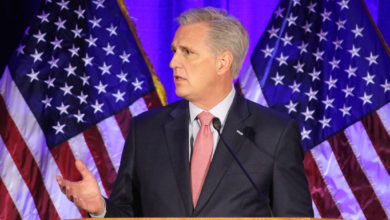Bank stocks took a beating when U.S. financial markets opened in the morning of March 13 after turmoil surrounding the collapse of Silicon Valley Bank and the contagion that spread to Signature Bank and Silvergate Bank. Whether or not this will lead to a greater banking crisis is still to be seen, but events so far have proven that the banking sector is not as safe as advertised and that the federal government is 100% prepared to secure Wall Street’s interests at the expense of everyone else.
The basics of what took place are a reflection of normal market activity, not simply “reckless” behavior by a few “bad apples.” In fact, if anything, the current banking crisis reflects how inherently reckless the entire global financial system is by design. It proves, yet again, that Marxist economics are correct: Crises are a feature, not a bug of capitalism. As Marx notes in the Manifesto of the Communist Party:
“Modern bourgeois society, with its relations of production, of exchange and of property, a society that has conjured up such gigantic means of production and of exchange, is like the sorcerer who is no longer able to control the powers of the nether world whom he has called up by his spells. … It is enough to mention the commercial crises that by their periodical return put the existence of the entire bourgeois society on its trial, each time more threateningly. … And how does the bourgeoisie get over these crises? … by enforced destruction of a mass of productive forces … by the conquest of new markets, and by the more thorough exploitation of the old ones. That is to say, by paving the way for more extensive and more destructive crises, and by diminishing the means whereby crises are prevented.”
Communist Manifesto
In just a little over two decades the capitalist system has gone into three major crises. The media gives these major economic shocks, with all of their attendant human suffering, particular names. First was the Dot-com crash in 2000; then in 2008, there was the Great Recession following the collapse of Wall Street banks, and then the COVID Recession of 2020. Each time we are told that there was a specific villain that caused the problem, but the cause of the problem is really the same. It is the way the capitalist economy is organized. In each crisis, it was the federal government that raced to bail out out the capitalists while millions of workers lost their jobs, homes and life savings.
Does the collapse of Silicon Valley Bank and Signature mean we are witnessing the start of the fourth major capitalist catastrophe? The government is racing to bail out the biggest capitalist banks — again!
And as usual the chorus of bourgeois commentators is out to promote this or that solution to the banking crisis, all designed to obfuscate the real cause of the issue: capitalism. However, as can be seen from the basics of our current moment, the crisis arose, not randomly, but from the very fabric of the “free market.” It can also be seen that the government’s response is really about protecting the ruling economic interests, not the welfare of working people, as they claim.
Why did the banks collapse?
The first thing to understand is that banks do not just store your money, they speculate with it. The role of banking in a capitalist economy is to mobilize “idle” money or other assets that can function as equivalents of money based on their value. Banks take the money that you or a corporation are not using, and lend it to other people and corporations who need to borrow money. So, the financial system is the cornerstone of capitalist dynamism. It makes sure money is where it needs to be, when it needs to be there, to facilitate the growth and operations of various parts of the economy.
This means, however, that banks do not actually have the cash on hand to cover all their deposits. Normally, this is not a big issue because not everyone is asking for their money all at once. Problems arise, as in the SVB case, when a large number of people do ask for their money all at once and the bank doesn’t actually have it, which is known as a “run on the bank.”
Banks often invest their money in “safe” assets like U.S. Treasury bills, or mortgages backed by the U.S. government because at the end of the day, people expect the U.S. government to always be able to pay. These assets can rise and fall in value. Most of the time that is fine because, again, as long as there is enough money to manage the normal flow of people or corporations withdrawing their funds, the bank can ride it out.
SVB and the others caught in this scandal, however, got caught flat-footed. As the Federal Reserve aggressively raised interest rates as part of a class warfare agenda, the value of their various government-backed securities fell. Then, Peter Thiel, one of the biggest players in their main area of technology and biopharmaceuticals, called on companies he was invested in to pull out their cash because the bank had issues. Others caught wind of that and started pulling out their money, and then, trouble really hit.
Due to the depressed value of the government-backed T-bills, the troubled banks couldn’t sell at a price to be able to cover the demands of their deposits from their customers. Once that became clear, more people wanted out, and that was when the government stepped in to prevent a total collapse. That is important because the financial system is deeply interconnected. If any other bank has similar asset profiles or investments in “troubled” banks or companies and now they can’t get their money, that then could recreate the whole process of a “run on banks.” People who still have cash on hand would stop lending until the chaos subsides, which further seizes up the financial system, and the next thing you know, the economy crashes.
Is this a bailout?
After the 2008 economic crash, the federal government ponied up $29 trillion to prop up “too big to fail” Wall Street institutions, while millions of workers lost everything, especially their homes. This understandably left the mass of working-class people, including the so-called “middle class,” deeply averse to the same thing happening in the future. With that in mind, the government has been at great pains to express that their “resolution” operations at SVB and elsewhere are not a bailout and that taxpayers are not on the hook to avoid a political crisis. No matter what they say, this is a bailout and taxpayers are on the hook.
Starting with the immediate operations at SVB and Signature, the government has reassured us all that, while they are covering even the uninsured deposits, any government money used will be replenished by a “special levy” on other banks. At first glance this sounds reassuring. However, don’t forget, the banks’ money is our money. We all pay an array of fees and interest to banks. So while the “levy” is coming from the banks’ wallets, how did they even get the profits and reserves they can use to pay in the first place? They got it from the money deposited by customers, the fees and interest it collects from them, and the profits it makes from speculating on the money and assets they’ve been entrusted with.
Second, the Federal Reserve has set up an essentially stealth bailout for banks that are in trouble that has yet to come to light. On March 11, the Fed announced the Bank Term Funding Program. This “facility” as Fed lending programs are known, allows banks to come to the Fed and exchange government-backed securities for a loan based on the face value of the asset. In other words, the Fed is going to loan banks money for these assets at terms better than what they could get on the market so that they can use that loan to cover the outflow of deposits. Further, the Fed noted that the government would initially issue $25 billion from the Treasury Department’s Exchange Stabilization fund to backstop the program.
Ultimately, then, the government is telling banks that know their balance sheet is looking a little dodgy, to come get their bailout money now. The thought is this will reassure investors because they will know they can get their money out and everything will calm down. That of course is a big assumption. Even with government involvement, it’s not inconceivable that further unsavory tales of risky banking, especially at the largest institutions, could cause major problems and financial crises. But even if it succeeds in the short-term, the government is still on the hook if any banks they lend to understate the scale of their problems and can’t pay the loan back.
So while it’s wrapped up in all sorts of financial jargon, the bottom line is that the government has pawned off some of the cost of saving insolvent banks onto customers of other banks, and is trying to prevent the crisis from spreading by putting taxpayer money on the line to contain the worst damage. If it can’t be contained, the government has also set the precedent that, yet again, they will step in to protect the “too big to fail” Wall Street behemoths.
What about the workers?
Of course capitalist propaganda has spent several days reminding the working class that capitalist companies are their employers and if the banks go down, the companies go down, and the biggest losers are really working-class people. Bailouts protect “the economy,” and so as unsavory as it might be, since we all “need” the “economy” to survive, noses must be held and cash must be doled out.
This is totally absurd and criminally misleading. It requires one basic assumption, that our capitalist economy as it currently exists is the only option. And that without this cycle of boom, bust and-bailout, no one can have nice things or anything at all. Even from the perspective of “reform” within the system, this is false. The government could very easily just let the banks fail, and make actual people and workers whole by just cutting them checks directly. We saw during the pandemic that they are perfectly capable of doing this. They could nationalize banks and make sure to inflict the most pain on those most able to pay, and use the socialized profits to fund the needs of those most harmed. Ultimately as the huge array of Fed-related acronyms — TARP, TALF, MMLF, and on and on — show, when push comes to shove every means of exotic sophistry can be used regardless of statute or precedent. It’s just that these powers are only used to help the biggest banks and corporations, which speaks directly to the fact that the Federal Reserve in particular, and the government more broadly, are interested primarily in protecting capitalism and capitalists, not people.
On a deeper level, capitalism is not the only way or the best way to organize the human and material resources of society to meet the needs and wants of the people who make up society. Socialism is more logical and more rational, putting people over profits and replacing the boom-bust anarchy of capitalist “investment” — gambling — with democratically-overseen planning, not leaving the wellbeing of the people to chance.
This current banking crisis is the perfect moment, not simply to expose the hypocrisies of the existing system, but to demand an entirely different one that can banish the pain and destruction of economic crises to the trash can of history.





